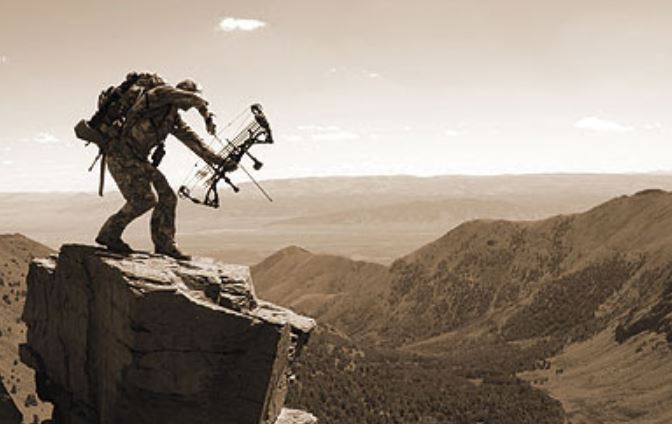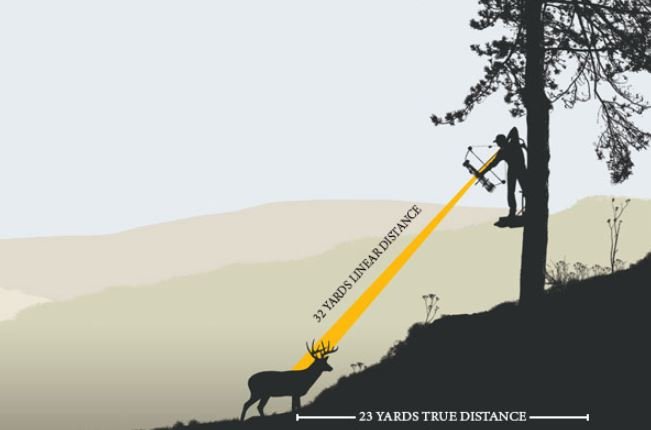Long term archery fans will know that it’s not always a case of standing still, pointing, and shooting at a target across level ground. If you hunt with a bow and arrow, you’ll be well aware that game has a tendency to wander into the hardest to reach places.
To become proficient with a bow, you must understand how to shoot both uphill and downhill. You don’t want to miss a target because you didn’t understand how to compensate for the angle. Archery Edge answers your question today!

Shooting uphill or downhill is a vastly different feel from shooting on level ground. It can play with your instincts, causing you to miss shots well within your range. Hunting relies heavily on instinct and reaction.
By trying to overcompensate for the new angle, inexperienced archers end up going the wrong way. Although it might not seem natural, when aiming at a target either uphill or downhill, you need to aim low.
Do you aim high or low when shooting downhill with a bow?
When shooting downhill with a bow, it’s important to aim low. It’s to do with compensating for the actual distance, understanding the perceived distance, and adjusting for arrow drop in the horizontal distance. Even though it might seem backwards, shooting low is the way to do it.

Essentially, there’s a lot of basic math behind why.
When you shoot from an elevated position, how we perceive distance changes. The distance as you see it to the target is not the same the distance that gravity sees to the target. Gravity only acts perpendicular to the Earth.
So when you shoot an arrow, what’s important to gravity is not the actual distance to the target, but the horizontal distance. The horizontal distance is how far away the target would be when stood on flat ground.
Gravity works on the arrow is it would on flat ground. The arrow travels the actual distance, but gravity only works on it for the horizontal distance.
So, as you shoot, you need to aim low to make up for the difference in distance. That’s to say, the difference between the actual distance and the horizontal distance. By aiming low, you make up for all the distance travelled that gravity doesn’t compensate for. Otherwise, the arrow won’t be acted on by gravity in the same way, and it will go high, missing your target.
To correctly calculate the horizontal distance the formula is horizontal distance² = actual distance² – vertical distance². Vertical distance is the change in height between you and the target. Eagle-eyed math fans may notice this is a take on Pythagoras’ theorem.
That’s because when you shoot a target from a height, you form part of a triangle. That’s between you, the target, and the base of the vertical distance.
To calculate the distances easily, a range scope will help. An angle-compensating laser rangefinder will do most of the work for you, if you don’t fancy equations. The best way to learn, and to avoid doing quick math, is simply practice.
By practicing shooting from different heights you can understand instinctively how to aim your shot. Practice will also help you adjust your stance. Proper form is important when shooting downhill (or uphill).
Unfortunately, form can be inadvertently dropped when adjusting to new angles. Practice keeps your form in check, and makes shooting downhill instinctive.
Do you aim high or low when shooting from a tree stand?
When shooting from a tree stand, you want to aim normally, or lower than normal. Aiming high will cause the arrow to miss, and your target to get away.

The arrow drop works based on the horizontal distance between the shot and the target, rather than the actual distance. Aiming high won’t compensate for arrow drop, so your target will miss.
Tree stands, downhill, and uphill shooting all function on the same principles. Gravity doesn’t change across hunting. If you’re using a tree stand it’s easier to calculate distance and take a more accurate shot, as you have more opportunity to check beforehand.
Set up still targets, and practice how much you need to compensate for the angle.
If you find yourself regularly missing tree stand shots, the issue may be with your stance. When aiming from a tree stand (or aiming uphill or downhill) it’s important to bend at the waist.
Many hunters will compensate by simply bending their arm to aim. However, this changes the angle between your sight and your bow. By bending at the waist, you maintain your stance and keep your eye inline with your arm.
Although the math may seem tricky at the outset, regular practice is the best way to learn. Try different angles and different distances to see how your accuracy changes.

